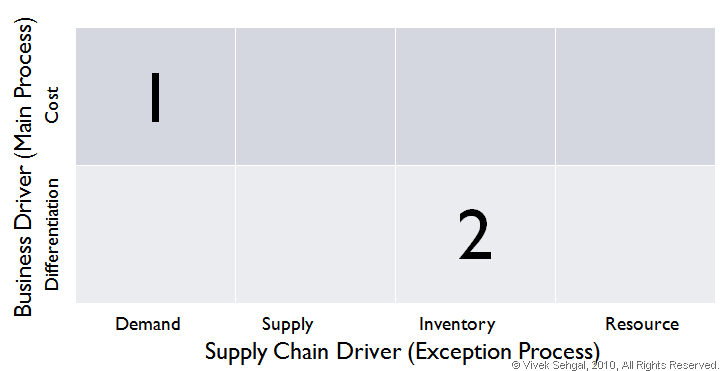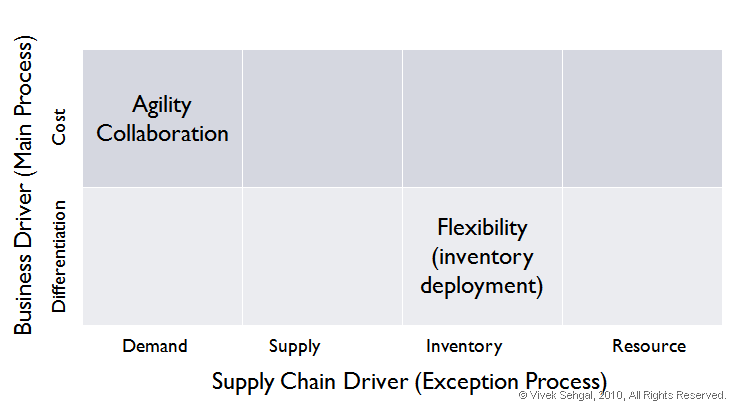If you have been following along this series on supply chain strategy so far, you would have gone through the conventional supply chain strategies of Lean, Agile, Speculation, and Postponement. In each one of these strategy reviews, I explained why they fall short of guiding a supply chain design in any meaningful way, finally introducing the supply chain sphere of influence and the need to identify what drives your supply chain.
With that context, let me introduce the new imperative for designing effective supply chains. This is based on recognizing the two basic facts about designing supply chain strategy:
- Supply chains can only manage demand, supply, inventory, and resources. Therefore, any strategy mandating supply chains to do anything else is not going to help. The supply chain driver is largely determined by the characteristics of the industry, products, and customers. The combinations of these attributes establish the basic nature and constraints of the supply chain capability requirements and therefore, it is largely not an option to be selected.
- Supply chains exist only to support a business, therefore, a supply chain strategy must sub-ordinate to the business strategy. This means that supply chain strategy cannot be designed in a vacuum, but must be aligned with an explicit business strategy. This is an explicit choice on behalf of the business and depends on the business model that a firm wants to pursue.
These two principles are shown graphically in the picture below. On the horizontal axis, identify the main supply chain driver from the supply chain sphere of influence. On the vertical axis, identify the main business driver (I have shown only cost or differentiation) that defines your business strategy/model. Remember these two align with the two core principles above. The business strategy driver helps in designing the main supply chain process orientation, for example, a cost-driven business will drive supply chain processes designed for asset-efficiency and high resource-utilization. The supply chain driver helps in designing how the exceptions will be handled within the supply chains – what happens when supplies don’t match demand, or enough inventories don’t exist within the network. Together, these drivers help design processes that match the organizational business objectives while simultaneously addressing the operational needs. And that together creates competitive advantage.
For example, if you selected a demand driven supply chain with cost as business strategy (cell 1 above, think of a typical retail supply chain), you would be designing processes with the intent of creating operational efficiencies while a supply chain with inventory as a driver and differentiation as the business strategy (cell 2, think of a typical aircraft maintenance supply chain) will focus on processes to provide flexibility in quick inventory deployments within the network. These characteristics are shown the picture below.
Of course, the supply chain design in the other cells intersecting at other possible combinations will follow their own prominent characteristics to suit the combined effect of business driver and the nature of supply chain operations mandated by the industry, product, and customer characteristics. These are discussed in detail in my book on supply chain strategy.
This is a new design imperative, a new concept, for designing effective supply chain strategy and building processes that create competitive advantages aligned with the needs of the business strategy of the firm – that is the basic theme of leveraging supply chains as an asset. While the conventional supply chain strategies will give you all the buzz-words, it is only through understanding the business goals and operational requirements, that you can actually build a supply chain strategy that is effective.
Next, I will cover some of the key characteristics of supply chain processes that must be designed for building competitive advantage and reaching your business goals.
Related Articles:
- What Drives Your Supply Chain?
- Supply Chain Sphere of Influence
- Conventional Supply Chain Strategies Explained: Lean, Agile, Speculation, and Postponement
- Supply Chain Strategies: Time to Refresh?
- Business Strategy & Supply Chains
© Vivek Sehgal, 2010, All Rights Reserved.
Want to know more about supply chains? How they work, what they afford, and how to design one? Check out my books on Supply Chain Management at Amazon.

